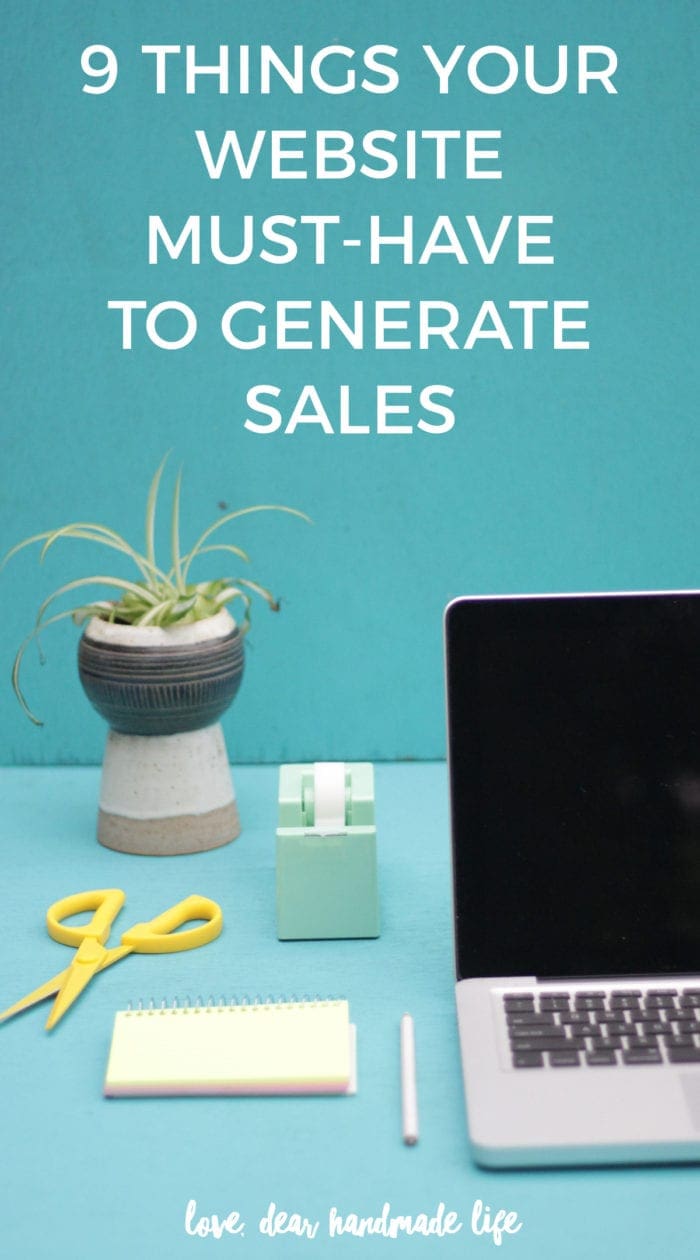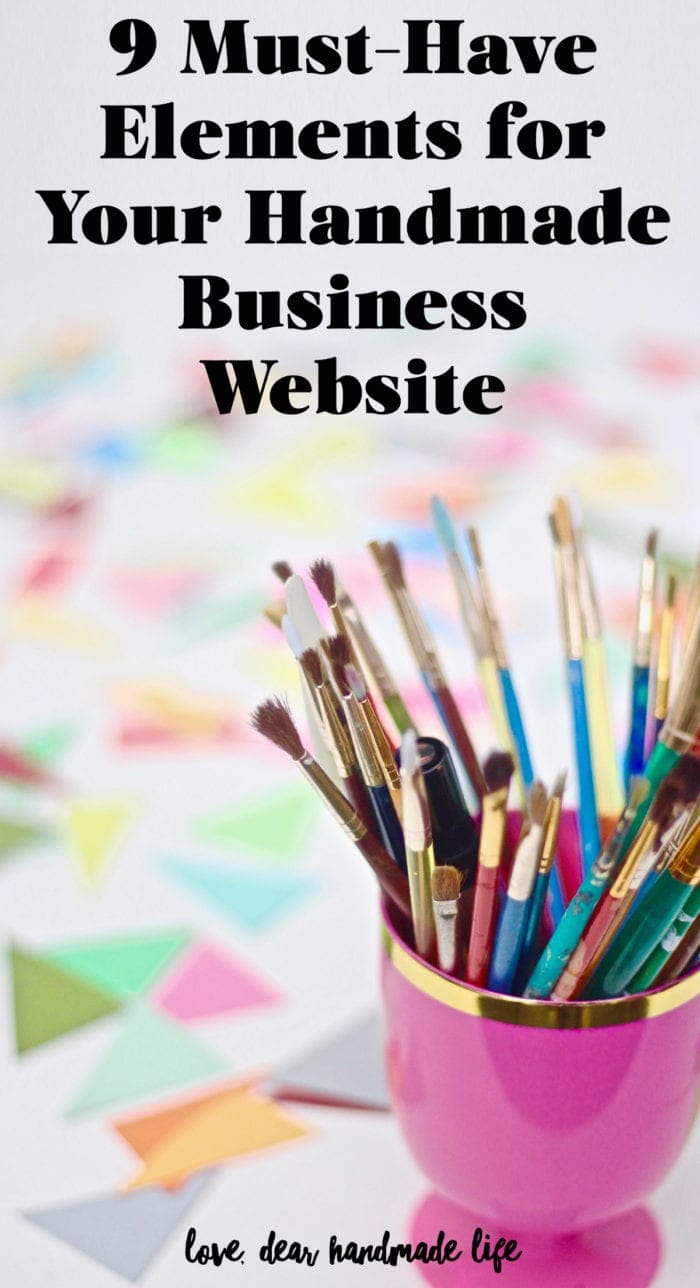9 Must Haves for Selling Successfully on Your Own Website
Editor’s Note: We’re excited to welcome Rebecca Inkrote to our blog for this guest post on 9 must-haves for selling successfully on your own website. Rebecca is a web designer and teacher for handmade business owners with ten years of experience creating websites which is why we jumped at the chance to have her share some tips with you.
We met Rebecca at our Craftcation: Business & Makers Conference and were overjoyed when she shared this about her experience at Craftcation Conference 2018:
“I really enjoyed my time in CA so much – I learned a lot and best of all I made some really awesome connections. The whole event was very well put together and everyone was so nice and easy to get along with. I’m really excited already for CC2019!” -Rebecca
We can’t wait to see Rebecca again at Craftcation Conference 2019. If you want to spend four life-changing days with us making, meeting and learning at the beach in California, mark your calendars for April 3-7, 2019. Registration opens October 5, 2018 at 9:00am PT.
-Nicole S.
Do Etsy’s recent announcements and changes have you re-visiting your desire to set up your own website? Or maybe the thought of increased transaction fees have lit a fire in you to improve and promote the website you already have. You probably know by now that it’s important to have your own website in addition to your Etsy shop, but maybe you feel overwhelmed by it all.
I know that creating and launching your own website seems like a lot of work. And of course, you want to be sure that your time and effort will actually lead to sales and better profit margins. Today I want to help you understand that yes, you can create a successful website for your business. These tips will help you ensure that your hard work will pay off by educating your potential customers and generating sales 24/7. Plus these sales will be even more profitable than selling on Etsy or at some in-person events because of the low overhead costs which are more fixed rather than percentage-based.
Whether you already have a website or you’re planning to build one in the future, these nine must-have website elements will help you to have a website that works for you and helps your business grow. Download and print out this summarized cheat sheet so you can take action.
1. A Cohesive & Successful Product Line
It may seem like a simple concept, but you’ve gotta sell what people want to buy! You want to make sure that the products you have on your website are those that are already tested, tried, and true. Curate a collection of products that are cohesive; they should carry a common theme or all appeal to a certain type of person.
2. Good Branding & Package Design
A solid logo design and brand can really elevate your product. Spend some time nailing down your brand message, style, and package design before you jump into making a website. Having a well-developed brand and style guide will make designing your website so much easier. If you already have a website, be sure that the design, style, and content on the site are aligned with your branding.
3. Great Photos
It is imperative to have high-quality, well-lit, and beautiful photographs of your products. Remember that people cannot hold your product and look at it up close, so they will rely on your photographs to really understand all the details. Great photos boost a visitor’s confidence while shopping. Be sure to have a great lifestyle photos for your home page (products in use, collections of products) in addition to amazing product photos for your listings. For lifestyle shots, consider how the customer will use your product. For example if you make jewelry: show how the piece lays on the skin and how it will complement certain outfits; allow your customers to see the size of the piece. For product photos, you probably want a tightly cropped images of your product on a clean and neutral background – your product is the number one focus. Entice shoppers with several angles, detail close-ups, and zoomable images.
4. A Way to Shop
Of course one of the main goals for your website is to sell your products, so you will need to make it easy for people to browse, shop, and purchase. This means adding on e-commerce capabilities to your website – probably with the WooCommerce plugin (free) for WordPress or by building a site with Shopify or another platform with e-commerce features. But if you’re not ready to build out the full e-commerce shop within your website just yet, that’s okay. In the meantime, you can simply create a link in your navigation menu called “Shop” and link it out to your Etsy shop.
5. An SSL Certificate
A what? Pardon the jargon! Have you noticed that most websites have a green padlock and https:// before the site URL? That’s because the website has what’s called an SSL Certificate. It means that any data entered into a form and sent through the site is encrypted before it’s transmitted through the interwebs. This is crucial if you have any forms that collect personal data, especially payment info! If you don’t have SSL on your site, you are risking the data your visitors input into your site and beginning in July 2018, the Google Chrome browser will mark plain http sites as ‘insecure’ and prominently highlight that in the URL bar. Contact your web host about adding SSL (easiest) or you can purchase through a third party. Personally, I recommend using a web host that offers this as part of your regular hosting service to make your life simpler.
6. Mobile-Friendly Design
More than 51% of all website traffic is from mobile devices. Don’t lose out on half your potential sales by having a website that’s not optimized for viewing on smartphones or tablets. When choosing a website platform and theme or template design, look for one that is ‘mobile responsive’. Responsive web design allows the content on your site to resize and rearrange to fit on any device so that the site is easily viewable on mobile. You can test pages on your site with Google’s Mobile-Friendly Test tool.
7. Easy to Use Design
Expanding on the last one, in addition to being mobile friendly, your website should also be easy to use and navigate overall. Your site should have a clean and uncluttered design with your logo and a navigation menu at the top. It should be fast to load since people don’t have much patience and will quickly ditch your site if it doesn’t load right away. You want to make it easy to navigate the pages on your site with a menu that easy to understand – avoid jargon or ambiguous menu items and instead opt for clarity, such as listing your primary categories so people can see instantly what you make. Within your shop area, you also want to make it easy to browse and shop by utilizing product categories (and sub-categories) and tags, as well as offering ways for visitors to sort, search, and filter your products. Continue this trend with a streamlined checkout process that accurately calculates and clearly displays shipping options and pricing.
8. Trust Signals
Trust is a huge factor affecting whether or not shoppers will feel comfortable and confident enough to make a purchase. Instill trust by letting visitors know about your business and how to contact you easily. Include an ‘About’ page that speaks to the desires of your customers, explains how your products fulfill those desires, and also to let the customer know more about you and your business. Include a ‘Contact’ page that offers multiple ways to reach out including phone, email address or online form, social media links, and even a physical address if applicable or at least a city and state if not. Some other ways to instill trust are: SSL / https, a Privacy Policy, Shipping & Returns info or ‘Customer Service’ page, and displaying customer testimonials or product reviews.
9. Marketing Strategy
If you build it, they won’t come… Your website is different than Etsy, Ebay, Amazon, or other marketplaces. People won’t simply stumble upon your website; you should be prepared to put a marketing plan into action in order to drive traffic to your website after you launch it. A website without traffic is about as useful as a car without a battery and gasoline. Spend some time creating a plan for how you will reach your ideal customers and send them to your website. Some common marketing techniques include: content marketing & SEO, influencer marketing, social media marketing, advertising (traditional and digital), brand ambassador programs, email marketing, PR, etc.
Next Steps
Creating an amazing website that turns shoppers into customers is a goal for many handmade business owners. The good news is that properly planning and implementing these must-have elements can help you make more sales with the traffic you get on your site.
If you already have a website, take some time to do a self-audit. Does your current website and strategy include these nine elements? If not, take note of what you’re missing and make a plan to improve in these areas. If so, awesome – you’re doing a great job and you can really be putting most of your focus on #9 and promoting your site. Maybe it’s even time to start a blog?
If you don’t have a website yet but you want one in the future, be sure to plan ahead before digging in. You want to choose a platform that will grow with you and allow you to hit all these points. You’re definitely ahead of the game now with a roadmap laid out to guide you as you build your website!
To help you even more, I’ve created this handy downloadable and printable cheat sheet summarizing these 9 must-have elements for your website. Get your copy today and use it as a roadmap for ensuring your website success!
About the Author:
Rebecca is a web designer and teacher for handmade business owners. She offers resources, courses, and educational content to help makers and handmade sellers expand beyond Etsy by creating and improving their own websites. Visit her website at bexmarie.com for more website tips, tutorials, and resources.





What a timely article. Thought my SSL Cert was live because on my admin site it looked it, but it really wasn’t. Did what I needed to do to correct that. So important. Thanks much for the reminder!!
Glad you got it fixed! Woo hoo!
Awesome! Yes it is so important. Glad this post helped remind you. Best of luck, Kristen!